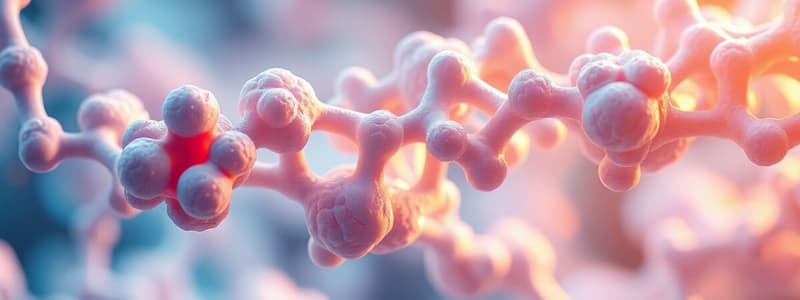Podcast
Questions and Answers
What is true about the structure of glycogen compared to amylopectin?
What is true about the structure of glycogen compared to amylopectin?
- Glycogen has longer branches than amylopectin.
- Glycogen is of lower molecular weight than amylopectin.
- Glycogen has fewer branches than amylopectin.
- Glycogen has more frequent and shorter branches than amylopectin. (correct)
What type of linkages do cellulose and chitin have?
What type of linkages do cellulose and chitin have?
- a(1→6) linkages
- a(1→4) linkages
- b(1→6) linkages
- b(1→4) linkages (correct)
Which of the following is NOT a structural polysaccharide?
Which of the following is NOT a structural polysaccharide?
- Amylopectin (correct)
- Chitin
- Glycosaminoglycans
- Cellulose
What is the primary function of heparin in the body?
What is the primary function of heparin in the body?
How are the peptides in the cell wall of Gram-positive bacteria linked?
How are the peptides in the cell wall of Gram-positive bacteria linked?
Which of the following carbohydrates is a monosaccharide?
Which of the following carbohydrates is a monosaccharide?
What is the role of carbohydrates in the immune system?
What is the role of carbohydrates in the immune system?
What distinguishes aldoses from ketoses among monosaccharides?
What distinguishes aldoses from ketoses among monosaccharides?
How is carbon numbering initiated in aldoses?
How is carbon numbering initiated in aldoses?
What is the significance of D-enantiomers in naturally occurring saccharides?
What is the significance of D-enantiomers in naturally occurring saccharides?
What molecular structure shows the configuration of groups around chiral carbons?
What molecular structure shows the configuration of groups around chiral carbons?
Which monosaccharide is an example of a triose?
Which monosaccharide is an example of a triose?
What does the R–S nomenclature indicate about a molecule?
What does the R–S nomenclature indicate about a molecule?
In the priority order for groups in carbohydrate chemistry, which group has the highest priority?
In the priority order for groups in carbohydrate chemistry, which group has the highest priority?
What is the absolute configuration of D-glyceraldehyde in terms of R-S nomenclature?
What is the absolute configuration of D-glyceraldehyde in terms of R-S nomenclature?
Which term describes isomers that differ in orientation about one specific chiral carbon?
Which term describes isomers that differ in orientation about one specific chiral carbon?
What are the two possible anomeric forms for cyclic saccharides?
What are the two possible anomeric forms for cyclic saccharides?
What defines the anomeric carbon in a cyclic saccharide?
What defines the anomeric carbon in a cyclic saccharide?
Which configuration is characterized by C-2 being above the defined plane in ribofuranose?
Which configuration is characterized by C-2 being above the defined plane in ribofuranose?
Monosaccharides with five or more carbons primarily exist in which structural form under physiological conditions?
Monosaccharides with five or more carbons primarily exist in which structural form under physiological conditions?
What defines the two most common conformations for ribose and deoxyribose in nucleic acids?
What defines the two most common conformations for ribose and deoxyribose in nucleic acids?
What type of reaction occurs during the formation of a glycosidic bond between two monosaccharides?
What type of reaction occurs during the formation of a glycosidic bond between two monosaccharides?
Which activated sugar molecule is involved in the biosynthesis of lactose?
Which activated sugar molecule is involved in the biosynthesis of lactose?
What distinguishes amylopectin and glycogen from amylose?
What distinguishes amylopectin and glycogen from amylose?
Which enzyme is responsible for catalyzing the formation of lactose in mammary tissue?
Which enzyme is responsible for catalyzing the formation of lactose in mammary tissue?
In what form is glycogen primarily stored in animals?
In what form is glycogen primarily stored in animals?
What defines the linkage between two sugar residues in a disaccharide like sucrose?
What defines the linkage between two sugar residues in a disaccharide like sucrose?
Which of the following statements about starch is accurate?
Which of the following statements about starch is accurate?
What is the role of glycosyltransferases in glycan biosynthesis?
What is the role of glycosyltransferases in glycan biosynthesis?
Which of the following correctly represents the structure of maltose?
Which of the following correctly represents the structure of maltose?
Which statement is NOT true about glycogen?
Which statement is NOT true about glycogen?
Which of the following statements about hexoses is true?
Which of the following statements about hexoses is true?
What distinguishes conformational isomers from configurational isomers?
What distinguishes conformational isomers from configurational isomers?
What type of acid is formed from the mild oxidation of an aldose?
What type of acid is formed from the mild oxidation of an aldose?
Which enzyme-catalyzed oxidation product results from the oxidation at carbon 6?
Which enzyme-catalyzed oxidation product results from the oxidation at carbon 6?
What are the natural products derived from the reduction of the carbonyl group in sugars called?
What are the natural products derived from the reduction of the carbonyl group in sugars called?
Which compounds are classified as amino sugars derived from glucose and galactose?
Which compounds are classified as amino sugars derived from glucose and galactose?
What bond is formed through the elimination of water between a cyclic monosaccharide and another compound?
What bond is formed through the elimination of water between a cyclic monosaccharide and another compound?
Which of the following glycosides is known to be toxic?
Which of the following glycosides is known to be toxic?
What structural aspect typically makes the chair conformation of sugars more stable than the boat conformation?
What structural aspect typically makes the chair conformation of sugars more stable than the boat conformation?
Which of the following correctly describes the relationship between free aldonic acids and lactones in solution?
Which of the following correctly describes the relationship between free aldonic acids and lactones in solution?
Flashcards
What are monosaccharides?
What are monosaccharides?
Simple sugars, the building blocks of carbohydrates, are known as monosaccharides. They are characterized by their single sugar unit and play a critical role in cellular energy production, signaling, and structural integrity.
What are aldoses?
What are aldoses?
Monosaccharides with an aldehyde group are called aldoses. These molecules contain a carbonyl group at the end of their carbon chain.
What are ketoses?
What are ketoses?
Monosaccharides with a ketone group are called ketoses. The carbonyl group in ketoses is located within the carbon chain.
What are enantiomers?
What are enantiomers?
Signup and view all the flashcards
What are Fischer projections?
What are Fischer projections?
Signup and view all the flashcards
What are D and L forms in monosaccharides?
What are D and L forms in monosaccharides?
Signup and view all the flashcards
What is glyceraldehyde?
What is glyceraldehyde?
Signup and view all the flashcards
Enantiomers
Enantiomers
Signup and view all the flashcards
R-S Nomenclature
R-S Nomenclature
Signup and view all the flashcards
Diastereomers
Diastereomers
Signup and view all the flashcards
Anomeric Carbon
Anomeric Carbon
Signup and view all the flashcards
Anomers
Anomers
Signup and view all the flashcards
C-2 endo conformation
C-2 endo conformation
Signup and view all the flashcards
C-3 endo conformation
C-3 endo conformation
Signup and view all the flashcards
Furanoses
Furanoses
Signup and view all the flashcards
Pyranoses
Pyranoses
Signup and view all the flashcards
What is an Anomeric Carbon?
What is an Anomeric Carbon?
Signup and view all the flashcards
What are Haworth Projections?
What are Haworth Projections?
Signup and view all the flashcards
What are Epimers?
What are Epimers?
Signup and view all the flashcards
What are Conformational Isomers?
What are Conformational Isomers?
Signup and view all the flashcards
What are Sugar Phosphates?
What are Sugar Phosphates?
Signup and view all the flashcards
What are Aldonic Acids?
What are Aldonic Acids?
Signup and view all the flashcards
What are Uronic Acids?
What are Uronic Acids?
Signup and view all the flashcards
What are Alditols?
What are Alditols?
Signup and view all the flashcards
What are Amino Sugars?
What are Amino Sugars?
Signup and view all the flashcards
What are O-Glycosides?
What are O-Glycosides?
Signup and view all the flashcards
Amylopectin
Amylopectin
Signup and view all the flashcards
Cellulose
Cellulose
Signup and view all the flashcards
Amylose
Amylose
Signup and view all the flashcards
Glycosaminoglycans (GAGs)
Glycosaminoglycans (GAGs)
Signup and view all the flashcards
Peptidoglycan
Peptidoglycan
Signup and view all the flashcards
What is a glycosidic bond?
What is a glycosidic bond?
Signup and view all the flashcards
How is a glycosidic bond described?
How is a glycosidic bond described?
Signup and view all the flashcards
What is the glycosidic bond present in sucrose?
What is the glycosidic bond present in sucrose?
Signup and view all the flashcards
What is the glycosidic bond present in maltose?
What is the glycosidic bond present in maltose?
Signup and view all the flashcards
What is the glycosidic bond present in lactose?
What is the glycosidic bond present in lactose?
Signup and view all the flashcards
How is a glycosidic bond formed?
How is a glycosidic bond formed?
Signup and view all the flashcards
What is the fate of a glycosidic bond?
What is the fate of a glycosidic bond?
Signup and view all the flashcards
What is a nucleotide-linked sugar?
What is a nucleotide-linked sugar?
Signup and view all the flashcards
What is the function of glycosyltransferases?
What is the function of glycosyltransferases?
Signup and view all the flashcards
Explain the different types of storage polysaccharides.
Explain the different types of storage polysaccharides.
Signup and view all the flashcards
Study Notes
Biochemistry I - CHM219
- Course instructor: Dr. Esra Aydemir
- Course title: Biochemistry I
- Course code: CHM219
Carbohydrates: Sugars, Saccharides, Glycans
- Carbohydrates have various functions in biochemistry, including generating and storing biological energy, molecular recognition (e.g., in the immune system), cellular protection (e.g., in bacterial and plant cell walls), cell signaling, cell adhesion, biological lubrication, controlling protein trafficking, and maintaining biological structure (e.g., cellulose).
- Monosaccharides are the simplest carbohydrates.
- Glucose is a monosaccharide.
- Maltose is a disaccharide containing two glucose units.
- Amylose is a glucose polymer found in starch.
Outline
- Monosaccharides
- Derivatives of the Monosaccharides
- Oligosaccharides
- Polysaccharides
- Glycoproteins
- Oligosaccharides as Cell Markers
- Biosynthesis of Glycoconjugates-Amino Sugars
- Glycoconjugates of Interest
Monosaccharides
- Trioses are the simplest monosaccharides.
- Aldoses and ketoses differ in the placement of the carbonyl group (aldehyde vs. ketone).
- Carbon numbering in aldoses begins with the aldehyde carbon, while in ketoses it begins with the carbon adjacent to the ketone group.
- D and L isomers are nonsuperimposable mirror images and are called enantiomers.
- D-enantiomers are the most important naturally occurring saccharides.
R-S Nomenclature
- The R-S system describes absolute stereochemical configuration according to defined rules.
- Priorities for groups common in carbohydrate chemistry are: SH > OR > OH > NH₂ > CO₂H > CHO > CH₂OH > CH₃ > H.
- View the molecule with the lowest priority group (usually H) away from you.
- If remaining groups decrease in priority in a clockwise direction, the absolute configuration is R.
- If priority decreases counterclockwise, the configuration is S.
Oxidation of Monosaccharides
- Oxidation of monosaccharides can create different products depending on the oxidizing agent used.
- Mild oxidation with alkaline Cu(II) (Fehling's solution) produces aldonic acids.
- Enzyme-catalyzed oxidation can produce uronic acids, such as glucuronic acid.
- Free aldonic acids can exist in equilibrium with lactones in solution.
Reduction of Monosaccharides
- Reduction of the carbonyl group on a sugar forms alditols.
- Important alditols include erythritol, mannitol, and sorbitol (glucitol).
Amino Sugar Derivatives
- Some amino sugars are widely distributed in natural polysaccharides.
- Examples include glucosamine and galactosamine derived from glucose and galactose
Glycosidic Bonds
- Elimination of water between an anomeric hydroxyl group of a cyclic monosaccharide and the hydroxyl group of another compound forms O-glycosidic bonds.
- These bonds are important in oligosaccharides and polysaccharides.
Oligosaccharides
- Two naturally occurring glycosides are ouabain and amygdalin, which are highly toxic.
- Disaccharides include lactose, sucrose, maltose, cellobiose and gentiobiose, each with varying structures.
- The distinguishing features of disaccharides include the specific sugar monomers, stereoconfigurations, the carbons involved in the linkage, the order of the monomers, and the configuration of the anomeric hydroxyl groups.
Glycoproteins
- Oligosaccharides and proteins can form glycoproteins in two ways: O-linked glycans are attached via threonine or serine hydroxyls, and N-linked glycans are via asparagine groups.
The ABO Blood Group Antigens
- The O oligosaccharide does not elicit antibodies in most humans.
- The A and B antigens are formed by the addition of GalNAc or Gal respectively, to the O oligosaccharide.
- Each antigen elicits a specific antibody.
- R can be a protein molecule or a lipid molecule.
Polysaccharides
- Starch (amylose and amylopectin) and glycogen are the principal storage polysaccharides in cells.
- Glycogen is primarily stored in the liver and muscles.
- Starch and glycogen are storage polysaccharides, making them important sources of energy for many organisms.
- Amylose is linear, while amylopectin and glycogen are branched.
Cellulose
- Cellulose is a structural polysaccharide in plants.
- Its (1→4) β-linkages make it a strong and structurally rigid polymer
- Another structural polysaccharide is chitin.
Organization of Plant Cell Walls
- Microfibrils of cellulose embedded in a matrix of hemicellulose.
- Cross-hatched fiber patterns give strength in all directions.
Glycosaminoglycans
- Major structural polysaccharides in vertebrate animals are glycosaminoglycans.
- Examples include the chondroitin sulfates, keratan sulfates, dermatan sulfates, and hyaluronic acid.
- All are repeating disaccharide units with either N-acetylgalactosamine, N-acetylglucosamine, or their derivatives.
- All are acidic due to sulfate or carboxylate groups.
Heparin
- A highly sulfated glycosaminoglycan used as a natural anticoagulant.
- It inhibits blood clotting enzymes.
Peptidoglycan
- Cell walls of Gram-positive bacteria (e.g., S. aureus) are composed of thick peptidoglycan layers.
- Peptides are cross-linked by glycine pentapeptides in the cell wall.
Gram-negative bacteria
- Cell walls of Gram-negative bacteria (e.g., E. coli) contain a thin peptidoglycan layer and an outer lipid membrane.
- Cross-links between tetrapeptides attached to NAM reside in adjacent chains.
Lipoteichoic Acid
- D-Alanyl and NAG groups are arranged irregularly in a chain.
- The chain is anchored in the membrane by lipid.
Influenza Virus Structure
- The influenza virus has a 13,600-nucleotide RNA genome packaged in a sphere about 120 nanometers in diameter.
- Spikes on the virion include hemagglutinin and neuraminidase molecules.
Rational Design of Neuraminidase Inhibitors
- Structures of sialic acid, zanamivir and oseltamivir
- Partial models of the neuraminidase-zanamivir complex show critical amino acid residues near the inhibitor binding site
Oligosaccharides as Cell Markers
- Animal cells have a glycocalyx, a thick sugar coat.
- Glycocalyx oligosaccharides interact with substances like bacteria in the intestine and collagen in the intercellular matrix.
Imaging Cell Surface Glycoproteins
- Zebrafish embryos can incorporate an azido derivative of GaINAc for imaging cell surface glycoproteins.
- Fluorescent reagents allow visualization of glycoproteins in living cells.
Biosynthesis of Glycoconjugates - Amino Sugars
- UDP-N-acetyl glucosamine is synthesized from glucosamine-6-phosphate.
- UDP-N-acetylneuraminic acid (sialic acid) is synthesized from UDP-N-acetylglucosamine.
Structures of N-linked Oligosaccharides
- The red boxes in the image outline the common pentasaccharide core
- All known N-linked structures share this core.
Glycoconjugates of Interest
- Biosynthesis of the lipid-linked oligosaccharide intermediate.
- The five sequential mannosyl transfer reactions from GDP -mannose.
- Four mannosyl transfers from dolichol phosphate mannose are catalyzed by separate glycosyltransferases.
- The lipid-linked oligosaccharide is synthesized in the ER and transferred to the glycoprotein acceptor site.
- Schematic pathway of oligosaccharide processing on newly synthesized glycoproteins.
Synthesis of Linear Peptidoglycan Molecule of S. aureus
- The peptidoglycan molecule is formed by adding N-acetylglucosamine and five glycyl residues to N-acetylmuramylpentapeptide.
- Undecaprenol phosphate acts as a carrier.
Cross-linking Reaction in Peptidoglycan Synthesis
- Cross-links between adjacent peptidoglycan chains are formed by transpeptidase enzymes.
- Penicillin structurally mimics the peptide substrate to inactivate the enzyme.
Biosynthesis of the Repeating Oligosaccharide Unit of the O Antigen of Salmonella Typhimurium
- First four reactions occur in the inner membrane.
- Activated tetrasaccharide unit is transferred to the unactivated terminus of a growing polysaccharide unit on the outside of the outer membrane.
Studying That Suits You
Use AI to generate personalized quizzes and flashcards to suit your learning preferences.




